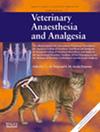Influence of acepromazine on the cardiovascular effects of dobutamine in isoflurane-anaesthetised horses premedicated with romifidine
IF 1.4
2区 农林科学
Q2 VETERINARY SCIENCES
引用次数: 0
Abstract
Objective
To explore the influence of acepromazine on the cardiovascular effects of dobutamine in isoflurane-anaesthetised horses premedicated with romifidine.
Study design
Prospective randomised clinical trial.
Animals
A total of 18 horses undergoing elective arthroscopy were enrolled, of which 12 horses requiring dobutamine were included.
Methods
Horses were randomised to receive acepromazine 0.02 mg kg-1 (Group A+) intravenously (IV) or none (Group A-), 35 minutes before anaesthesia. Horses received xylazine 0.2 mg kg-1 concurrently to facilitate IV access. Horses were premedicated with romifidine 0.08 mg kg-1, induced with ketamine 2.2 mg kg-1 and diazepam 0.08 mg kg-1 IV, and maintained with isoflurane in oxygen. Dobutamine infusion was commenced when mean arterial pressure (MAP) was < 60 mmHg. Cardiovascular data were collected prior to dobutamine, and at a target MAP of ≥ 70 mmHg. Dobutamine start time from induction, duration and dose to reach target MAP were compared using Mann-Whitney U test. Cardiovascular variables were compared using repeated measures ANOVA and post-hoc Fisher’s least significant difference test.
Results
Cardiac index (CI) and its percentage change from baseline were significantly higher at target MAP in group A+ [62.0 (49.9–74.2) mL minute-1 kg-1; 42.8 (17.0–68.7) %] than in A- [49.5 (39.6–59.5) mL minute-1 kg-1; -4.05 (-21.2–13.0) %] (p = 0.049; p = 0.003). Group A+ required significantly earlier dobutamine [20 (18–25) minutes] than group A- [36 (27–60) minutes] (p = 0.02). Group A+ required significantly higher dobutamine dose [1.5 (1–2.5) μg kg-1 minute-1] to reach target MAP than group A- [0.5 (0.5–1) μg kg-1 minute-1] (p = 0.009).
Conclusion and clinical relevance
Dobutamine significantly increased MAP and CI following pre-anaesthetic acepromazine sedation, in isoflurane-anaesthetised horses premedicated with romifidine. Without acepromazine, dobutamine increased MAP but not CI. Interactions between acepromazine, romifidine and dobutamine on the cardiovascular system should be considered.
乙丙嗪对异氟醚麻醉马预先注射罗米非定后多巴酚丁胺心血管效应的影响。
目的:探讨乙酰丙嗪对罗米非定预用药异氟醚麻醉马多巴酚丁胺心血管作用的影响。研究设计:前瞻性随机临床试验。动物:共有18匹马接受选择性关节镜检查,其中12匹马需要多巴酚丁胺。方法:马随机分为两组,麻醉前35分钟静脉注射乙酰丙嗪0.02 mg kg-1 (A+组)或不给药(A-组)。马同时给予噻嗪0.2 mg kg-1以方便静脉注射。用罗米非定0.08 mg kg-1预用药,氯胺酮2.2 mg kg-1和地西泮0.08 mg kg-1 IV诱导,异氟烷氧维持。当平均动脉压(MAP) < 60 mmHg时开始输注多巴酚丁胺。在多巴酚丁胺治疗前收集心血管数据,目标MAP≥70 mmHg。采用Mann-Whitney U检验比较多巴酚丁胺诱导起始时间、持续时间和到达MAP目标的剂量。采用重复测量方差分析和事后Fisher最小显著性差异检验比较心血管变量。结果:A+组心脏指数(CI)及其与基线相比的百分比变化明显高于目标MAP [62.0 (49.9-74.2) mL min -1 kg-1;42.8(17.0-68.7) %]比A- 49.5 (39.6-59.5) mL min -1 kg-1;-4.05 (-21.2-13.0) %] (p = 0.049;P = 0.003)。A+组多巴酚丁胺需要量[20 (18-25)min]明显早于A-组[36 (27-60)min] (p = 0.02)。A+组达到MAP目标所需多巴酚丁胺剂量[1.5 (1-2.5)μ kg-1 min -1]显著高于A-组[0.5 (0.5-1)μ kg-1 min -1] (p = 0.009)。结论及临床意义:多巴酚丁胺显著增加异氟醚麻醉马在麻醉前乙酰丙嗪镇静后的MAP和CI。不加乙酰丙嗪时,多巴酚丁胺增加MAP,但不增加CI。应考虑乙酰丙嗪、罗米定和多巴酚丁胺对心血管系统的相互作用。
本文章由计算机程序翻译,如有差异,请以英文原文为准。
求助全文
约1分钟内获得全文
求助全文
来源期刊

Veterinary anaesthesia and analgesia
农林科学-兽医学
CiteScore
3.10
自引率
17.60%
发文量
91
审稿时长
97 days
期刊介绍:
Veterinary Anaesthesia and Analgesia is the official journal of the Association of Veterinary Anaesthetists, the American College of Veterinary Anesthesia and Analgesia and the European College of Veterinary Anaesthesia and Analgesia. Its purpose is the publication of original, peer reviewed articles covering all branches of anaesthesia and the relief of pain in animals. Articles concerned with the following subjects related to anaesthesia and analgesia are also welcome:
the basic sciences;
pathophysiology of disease as it relates to anaesthetic management
equipment
intensive care
chemical restraint of animals including laboratory animals, wildlife and exotic animals
welfare issues associated with pain and distress
education in veterinary anaesthesia and analgesia.
Review articles, special articles, and historical notes will also be published, along with editorials, case reports in the form of letters to the editor, and book reviews. There is also an active correspondence section.
 求助内容:
求助内容: 应助结果提醒方式:
应助结果提醒方式:


